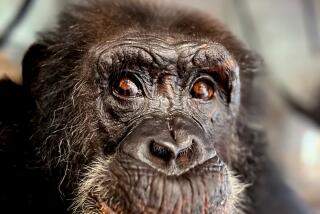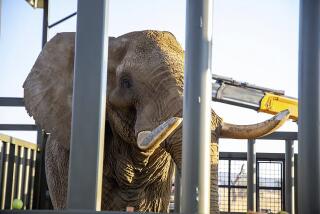At 300-Plus Pounds, This Baby’s a Handful
Keepers at the Oakland Zoo were surprised to find a newborn male lying among the African elephants one cool morning last November. The animal’s mother was even more clueless--when the new arrival could stand on its wobbly legs, she swatted him with her trunk.
By the end of the day, zookeepers had whisked the 190-pound infant away to embark upon a rare, controversial and largely uncharted journey--they would hand-rear the baby elephant.
Now, three months later, Kijana--Swahili for “little boy”--is thriving as the first African elephant since 1984 to be born in captivity and survive.
He owes his survival so far to meticulous and expensive care--totaling about $120,000 a year. Daily, Kijana sucks down about 40 pints of specially created formula flown in from Canada and served in a giant bottle, warmed by microwave and fed to him by human hand.
He is attended round the clock by a select handful of zoo staffers and volunteers who feed him, clean up after him, sleep next to him through the night and chart his every mood and bodily function. When they wrap their arms around his body and coo “what a good boy” he responds with a low rumble--the elephant equivalent of a greeting.
Standing a mere 38 inches high, Kijana seems more like a big golden retriever with a trunk than a fledgling behemoth. But he already weighs 304 pounds and gains about a pound a day. His friendly game of head-butting can almost knock an adult down.
How the zoo will bottle-feed a 1,000-pound elephant with tusks--he will need milk for the next two years--remains to be seen.
“It’s going to be an experiment for everyone,” says Allison Lindquist, an instructor at the zoo and one of Kijana’s night baby sitters.
Even more daunting will be the task of reintroducing the young male to the zoo’s herd of African elephants, which now regard him warily through bars in the elephant barn. The 14,000-pound bull that sired Kijana could kill him.
In about two years there will come a point of no return when he will be placed on one side of the fence with his bigger, stronger relatives--and the human handlers who once covered him with quilts at night will have to watch from the other side.
“Once you open the gate, nature takes over and we can’t intervene,” says Joel Parrott, the zoo’s executive director and a veterinarian.
Kijana’s birth comes at a time when zoos everywhere are reevaluating the handling of elephants--highly social and intelligent animals that can live 60 years in captivity and roam long distances in the wild.
The Oakland Zoo practices an innovative style of elephant management called “protected contact” that allows elephants more room to roam and eschews physical discipline--but leaves keepers with much less control over the animals. Supporters praise it as more humane.
The zoo adopted the practice in 1991 after its 14,000-pound bull Smokey--going through a period of “must,” when males assert their dominance--killed a keeper, apparently by breaking the man’s neck with his trunk then stepping on him. Now, no elephant at the zoo is ever hit. And except for a few situations when elephants are chained for physical care, no elephant is severely restrained-- and no keeper comes in close contact with the animal unless protected by a barrier.
But one elephant care consultant believes protected contact may have made the Oakland Zoo’s situation with Kijana more difficult.
“We can’t relinquish control,” says Alan Roocroft, elephant manager at the San Diego Wild Animal Park (which also now uses protected contact). “It would have been better [for the Oakland Zoo] to have that cow on chains. You take the baby away, do medical tests, and then gradually reintroduce it to the mother.”
In fact, the Oakland Zoo personnel maintain, they did chain the mother on the day of the baby’s birth--and may have inadvertently made her more aggressive.
Although they can’t prove it, staffers say the change to gentler handling of their four females and one male has led the bull to breed. Two weeks after 17-year-old Lisa gave birth to Kijana, another female, Donna, gave birth to a baby--with a severely damaged leg--which ended up having to be destroyed. Its mother wailed mournfully for hours that day.
So far, Kijana has sailed through his first three months of infancy.
On one recent morning, Kijana shuffled along behind Colleen Kinzley, the zoo’s general curator and elephant manager, as she carted a wheelbarrow of dirty hay out of the barn. Kinzley, who lives at the zoo, spends as much as 10 hours a day and three nights a week with Kijana.
As a result, he follows her devotedly, often raising his trunk as a sign that he wants to be fed. During the day, he nurses every half hour. “At night, he sleeps about an hour, maybe an hour and a half,” says Kinzley, 30, “then he drinks a pint and goes right back down.”
When it is Kinzley’s turn to baby-sit, she sits with Kijana and waits for him to fall asleep against a hay bale, gently discouraging him from clambering on top of her (which he would do with his natural mother). Then she curls up behind him, often awakening to find Kijana stretching his trunk over his head to fiddle with her bangs.
In the first few weeks of Kijana’s life, the zoo made frantic efforts to get his formula right. It was crucial to his development, but formula for Asian elephants wasn’t working. Some veterinarians suggested the zoo try Infamil, a human baby formula.
Five years ago, the San Diego Wild Animal Park had tried to hand-rear a baby Asian elephant, Omar, but it had to be euthanized at nine months due to a metabolic bone disease--which San Diego officials attribute at least partially to the inability to provide him the nutrients found in his mother’s milk.
Luckily the Oakland Zoo got milk from Donna, the mother of the baby that did not survive, and had that analyzed by the Canadian company that produces Kijana’s formula. The zoo supplements the formula with small amounts of milk expressed daily from Donna.
Kinzley literally sits under the female elephant and, using a breast pump, reaches up to her teats and squeezes out what she can. For this undertaking, two of Donna’s legs are chained and she is distracted with a steady supply of alfalfa treats. Even so, her cooperation is essential. “If she doesn’t want you to do it, she won’t let you,” says Kinzley.
The cost of formula alone will be $20,000 the first year of Kijana’s life. A fund set up to care for Kijana has raised $37,000.
He has become a popular attraction at the 74-year-old zoo in Oakland’s Knowland Park. When he takes his daily walk on a grassy slope, clusters of visitors snap pictures and pepper his handler with questions. When he stumbles on the grass, a chorus of sympathetic “Ohhhhh!” rises from the crowd.
Outside his barn, Kijana wanders around with a blanket draped over him for warmth. His back is sparsely covered with bristly black hair and the undersides of his ears feel like polished leather.
He makes a beeline for a photographer’s camera, wrapping his trunk around the lenses before exploring the photographer’s hairline. That finished, he uses the two little protruding fingers on the end of his trunk to untie a visitor’s shoelaces.
“His trunk used to be this thing that was just hanging there,” says Lindquist. “The fact that he can now reach for your nose is different.”
Mindful that one day very soon he will be overpowering, zoo staffers are now discouraging his playfulness with them. “We’re trying to curb those kinds of behaviors that will turn into aggression or inadvertent injury,” says Kinzley.
It will take months to gradually get the rest of the “herd” comfortable with Kijana. Now, they all sleep in the same barn--but Kijana is separated by steel bars from the adult elephants. He ignores them.
“I’m sure he’ll spend a lot of time visiting with them through the fences,” says Kinzley. “We want the novelty of him to be absolutely gone before we put him in with them.”
Kinzley even speculates that there might be a way to put Kijana into the one-acre elephant “exhibit”--but leave a kind of escape hatch big enough for him but too small for the others.
Still, it’s hard for his baby sitters to envision. Lindquist watches in awe as Smokey flings his trunk about in his watering hole. “I just can’t believe little Kijana is going to be that big,” Lindquist says a little wistfully, “and I won’t be able to go near him.”
More to Read
Sign up for Essential California
The most important California stories and recommendations in your inbox every morning.
You may occasionally receive promotional content from the Los Angeles Times.











